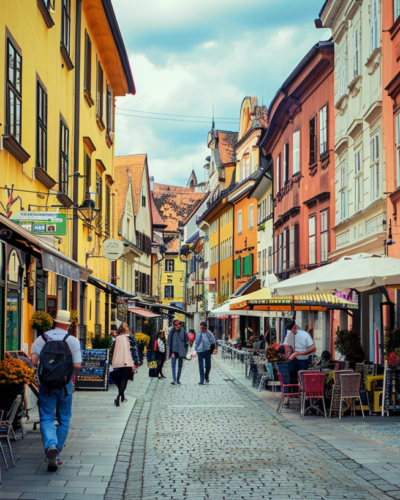Step back in time with a visit to Italy’s most picturesque medieval towns. Experience the timeless beauty of San Gimignano, the rich history of Siena, the spiritual depth of Assisi, and the Renaissance allure of Montepulciano. Join us as we unveil the secrets and splendor of Italy’s medieval treasures.
Welcome to Medieval Italy, where every cobblestone street, historic wall, and majestic cathedral tells a story. The past is clearly a vivid part of a local’s daily life in these quaint towns. As you wander through the narrow lanes of Italian medieval towns, you’ll feel as though you’ve stepped back centuries.
For one, the architecture stands resilient and proud, showcasing the ingenious artistry and the turbulent histories these towns have witnessed. From the North’s guarded fortresses to the South’s sunlit piazzas, each town offers a unique window into the medieval era, celebrated through preserved buildings, traditional festivals, and local legends that still whisper in the air.
The Magic of Medieval Towns
Italian medieval towns are more than just your typical holiday destinations. Most serve as timeless capsules of human genius. But what makes these towns truly extraordinary is their ability to maintain their medieval character while continuing to be the vibrant communities they are today.
Imagine walking through the same archways where merchants of the past once traded goods or gazing upon ancient frescoes that have inspired generations. These towns undoubtedly weave crucial threads in the fabric of Italian culture, each contributing a distinct pattern to the nation’s rich identity. The enduring structures and age-old traditions of places like San Gimignano or Montepulciano are living museums that offer detailed characteristics of the country’s architectural styles such as Romanesque churches and Gothic cathedrals, while also opening up portals into the societal norms and communal life of their times. This blend of beauty and history makes exploring these towns a certainly rewarding journey into medieval Italy.
Top Medieval Towns to Visit in Italy
With that, let’s discover some of Italy’s most captivating medieval towns that usher in our gateway to the past where history, architecture, and culture vividly coexist. From the towering fortresses of Tuscany to Umbria’s spiritual sanctuaries, these destinations offer a profound connection to an era rich with artistic and historical significance. Climb ancient towers, wander through awe-inspiring basilicas, and stroll along cobbled streets that echo the footsteps of medieval citizens. These landmarks are 100% must-visit hotspots that will let you truly experience the heart of medieval Italy.
San Gimignano
San Gimignano, often described as the “Manhattan of the Middle Ages,” is famed for its fourteen towering medieval structures that punctuate the Tuscan skyline. As you step into this UNESCO World Heritage site, you’ll be immediately transported back to an era of flourishing art and commerce. After all, these towers were true symbols of wealth and power in the past.
The town’s architecture offers an intricate display of medieval urban planning and Gothic elements. The Piazza della Cisterna itself is a charming triangular square, surrounded by beautifully preserved towers. It’s the perfect spot for savoring local gelato while soaking in the historical atmosphere. But for the best views, climb the Torre Grossa, the tallest tower, which provides sweeping vistas of the surrounding countryside.
One crucial tip, though. Time your visit during the off-peak seasons in spring or fall for a more serene experience.
Siena
The city of Siena captures the essence of medieval grandeur with its fan-shaped Piazza del Campo, renowned worldwide for hosting the Palio di Siena horse race. This historic square is framed by various architectural wonders, including the Palazzo Pubblico with its impressive frescoes and the towering Torre del Mangia.
A short walk away, the Siena Cathedral also stands as a masterpiece of Italian Gothic architecture, with its intricate facade and a stunning mosaic floor that is periodically uncovered for public viewing. Visitors can delve deeper into local history by exploring the extensive network of medieval streets that offer authentic Tuscan cuisine and artisan shops and staying in Tuscan countryside.
To fully experience Siena’s vibrant culture, plan a visit during the Palio, held annually every 2nd of July and the 16th of August. During these festivities, the city bursts into life with historical parades and community festivities you’ll surely enjoy!
Assisi
Most people associate Assisi as the birthplace of St. Francis, the patron saint of the animals and environment. Up close, it’s really a peaceful sanctuary where spirituality permeates the air. The town is dominated by the two-level Basilica of St. Francis, where visitors can admire some of the most important medieval frescoes in the world, including works by Giotto and Cimabue.
Venture beyond the basilica, and you’ll find Assisi offers a labyrinth of narrow streets lined with stone houses, quaint shops, and small cafes, each corner and courtyard telling stories of centuries past. The Rocca Maggiore castle on a hilltop above the town provides a panoramic view of the Umbrian landscape, ideal for photographers and history enthusiasts alike.
Visitors can also consider checking-in at medieval inspired stays like Agriturismo Basaletto. Outside, you can participate in a walking tour to further appreciate Assisi’s rich history and spiritual significance. Make visits during the Feast of St. Francis in early October for a truly memorable experience.
Montepulciano
When talking about Italian medieval towns, Montepulciano is a generous treasure trove of Renaissance architecture and gastronomic excellence. This Tuscan hill town is celebrated for its Vino Nobile di Montepulciano wine, which you can taste in various ancient wine cellars turned into welcoming tasting rooms beneath the town.
Walking through Montepulciano, visitors may encounter grand palaces like Palazzo Tarugi and Palazzo Contucci, and the stunning Piazza Grande at the town’s highest point. The town’s churches, like the San Biagio, also represent Renaissance beauty set against the backdrop of lush Tuscan vineyards.
For a more enriching experience, join a local wine tour to learn about the traditional methods of winemaking that have been passed down through generations. We recommend you to visit during the grape harvest in September or when the town hosts its annual wine barrel racing contest in late August, so you can witness how the city blends culture with all the fun and excitement it has to offer.
Experiencing Authentic Medieval Italy
You can surely immerse yourself in medieval Italy by engaging with the local culture beyond the usual tourist paths. Why not participate in traditional festivals that offer vivid windows into the country’s past?
For instance, the Medieval Festival in Monteriggioni features jousts, archery, and artisans at work. Culinary enthusiasts can delve into the medieval flavors with dishes like wild boar ragu or truffle-infused pastas, best enjoyed in a rustic osteria. Guided tours, especially those led by local historians, can likewise enhance your understanding of the architectural marvels and layered history of these towns.
To foster truly genuine connections, consider visiting during off-peak seasons like late autumn or early spring when the towns are quieter and the ambiance more reflective of everyday medieval life. This timing not only allows for deeper cultural immersions but also offers the chance to interact more personally with local residents and artisans, who, after all, are the true keepers of these ancient traditions.
Planning Your Trip: Tips and Essentials
When planning your journey to Italian medieval towns, thoughtful preparation can surely make your trip both enjoyable and smooth. Start by considering your transportation options. Many of these towns are best accessed by regional trains from major cities, followed by local buses or even walking for the final stretch.
When booking accommodations, make sure you do it well in advance, especially if you aim to attend popular festivals or during the summer months. Staying in a historic hotel or a traditional bed and breakfast can greatly enhance your medieval experience.
For optimal weather and fewer crowds, plan your visit in the shoulder seasons— late spring or early autumn. These periods offer mild weather and the lush landscapes of Italy are in full bloom or richly colored by fall hues.
Lastly, always check local travel advisories and book tickets for major attractions ahead of time to avoid long lines, ensuring a seamless and enriching travel experience.
Share Your Medieval Experiences With This City Knows
Exploring Italian medieval towns is like stepping into a vibrant tapestry of history, where each cobblestone and corridor has a story to tell. From the towering fortresses of San Gimignano to the spiritual sanctuaries of Assisi, these towns offer an enriching journey through time.
Embrace the opportunity to uncover the architectural wonders and cultural treasures of medieval Italy on your next travel adventure. And when you do, share your memorable experiences and stunning photographs with us at This City Knows. We’re always eager to hear how these historic gems captivated your heart and imagination!









